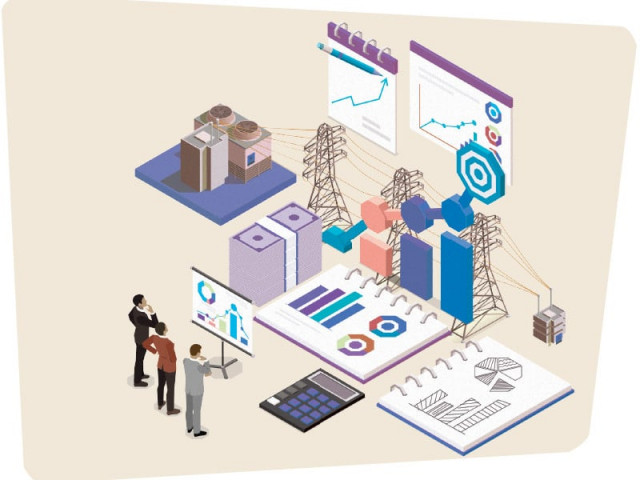Circular debt may swell to Rs2.8tr
Without subsidies and despite tariff hike, debt will touch new record high

Despite increasing electricity prices up to 51% in July, the government has projected that the power sector's circular debt could jump to a new record high of Rs2.8 trillion by the end of current fiscal year without any injection of budgetary subsidies.
Ministry of Energy sources told The Express Tribune that the gross addition to the circular debt had been estimated at Rs417 billion for fiscal year 2024-25 in spite of raising power tariffs from July.
The circular debt stood at Rs2.383 trillion by June this year, already higher than the commitment given to the International Monetary Fund (IMF) and more than the threshold approved by the federal cabinet last year under the Circular Debt Management Plan 2023-24.
After adding an estimated Rs417 billion, the debt will jump to Rs2.8 trillion by taking into account the power sector losses and inefficiencies.
Sources said that under an understanding reached with the IMF, the government would provide Rs381 billion in subsidies from the budget. This will restrict the debt to Rs2.42 trillion by June next year.
The Power Division, however, has a poor record of achieving end-June debt reduction targets, set by the IMF and the cabinet.
Power Secretary Dr Muhammad Fakhre Alam did not respond to a request for comment on the new targets.
Last year, the bureaucracy seemed to be focused more on launching campaigns rather than bringing about real improvement in the energy sector. The World Bank and IMF-dictated energy policies and the government's failure to stem theft and losses have resulted in a situation where neither the debt is eliminated nor the electricity remains affordable.
The average per-unit electricity now costs around Rs64 to Rs72 for residential and commercial consumers after including all taxes and surcharges.
Prime Minister Shehbaz Sharif has approved a further increase in electricity prices by up to Rs7.12 per unit, or 51%, for the current fiscal year. The new rates have already come into effect except for consumers of up to 200 units of electricity per month. For them, the new rates will be effective from October 1.
Instead of ensuring real improvement in the energy sector, the coalition government has increased prices for 32.5 million consumers, mainly households. Among these consumers, 26 million fall in the category of poorest and low middle-income groups – the segments that have borne the maximum increase in prices in percentage terms.
Sources said that according to the new Circular Debt Management Plan, the debt was projected to increase by Rs245 billion to Rs2.63 trillion during the first quarter (Jul-Sept) of the current fiscal year.
The increase is said to be because of low payment of subsidies, estimated at only Rs12 billion, for the quarter.
By the end of December, the Power Division has projected that the debt will surge to over Rs2.7 trillion – an addition of Rs330 billion in the first half of FY25.
By March 2025, the circular debt is projected to peak at Rs2.8 trillion. However, the Ministry of Finance will inject subsidies of Rs381 billion to bring down the debt to Rs2.42 trillion before the end of the current fiscal year. Yet, there will be a net addition of Rs36 billion to the debt.
For the last fiscal year, the IMF had asked the government that there should be zero addition to the debt stock of Rs2.310 trillion on the back of a tariff increase of Rs8 per unit and huge budget subsidies. Nonetheless, the debt jumped to Rs2.383 trillion by June this year.
Electricity prices have become unaffordable for a majority of Pakistanis after a consistent rise in tariffs to cover losses and inefficiencies of the power sector. In July 2022, the government raised tariff by Rs7.91 per unit and jacked it up by Rs8 per unit in July 2023.
For the last fiscal year, the Ministry of Finance had set aside Rs976 billion in subsidies to keep the debt at Rs2.31 trillion in line with an agreement with the IMF.
The government has already slapped a debt servicing surcharge of Rs3.23 per unit to service the debt parked in a holding company. But it does not cover the interest expense being paid to the IPPs on delayed payments.
The Pakistan Democratic Movement (PDM) government had also launched an anti-theft campaign last year, with the backing of the Special Investment Facilitation Council. The then power secretary, now the Federal Board of Revenue (FBR) chairman, came up with the idea of appointing top officers of the three intelligence agencies and the police in power distribution companies to check electricity theft.
The increase in circular debt can be attributed to poor recoveries by the distribution companies, high system losses, pending generation costs, non-payments by K-Electric and interest charges. The biggest increase was often caused by the distribution companies because of under-recoveries, inefficiency and losses.
Jamaat-e-Islami on Monday renewed its threat for protests after its 45-day deadline for reduction in electricity prices ended. The government shared with the IMF a Rs2.8 trillion plan to reduce prices by Rs6 per unit but the lender rejected the proposal built on flimsy numbers.



















COMMENTS
Comments are moderated and generally will be posted if they are on-topic and not abusive.
For more information, please see our Comments FAQ